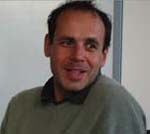UCSF team controls zebrafish heart rate with optical pacemaker

Didier Stainier, PhD
UCSF researchers have for the first time shown that an external optical pacemaker can be used in a vertebrate to control its heart rate.
The model, which has been tested in zebrafish, is being examined as a research tool for understanding cardiac and blood vessel development, with future possibilities as a noninvasive way to treat human cardiac arrhythmias.
Findings are described in the Nov. 12 issue of Science magazine and will appear online at www.sciencemag.org.
Specialized heart muscle cells, known as pacemaker cells, control the human heartbeat, the researchers explained. In patients with arrhythmias, the dysfunctional natural pacemaker can be replaced with an implanted, electrical pacemaker. Such implants save lives, but their application is limited, since the electrical pulses produce toxic gases (hydrogen, oxygen, chlorine), according to the paper. As a result, those pulses must be very short and not too strong.
To overcome these shortcomings, UCSF researchers in the laboratories of professors Didier Stainier, PhD, in Biochemistry and Biophysics, and Herwig Baier, PhD, in Physiology, genetically added specific proteins to the heart muscle cells of zebrafish to make them sensitive to light.
The team then used a consumer-market video projector commonly used for Power-Point presentations to project a light pattern onto the tiny, live zebrafish heart to precisely control its heart rate. The team found the heart rate could be reduced (even to a full stop, see movie 1) or increased (movie 2) with well-defined light pulses to the heart, without touching the fish.
“The new method allows us to silence or activate muscle and nervous tissues at will, and with great temporal precision,” said Aristides Arrenberg, PhD, who conducted the research at UCSF in collaboration with Jan Huisken, PhD, and is now a postdoctoral fellow at the Institute of Biology in the University of Freiburg, Germany. “It is a promising tool for answering open questions in the biological sciences.”
A somewhat similar method recently was tested in the mouse heart by a team from Bonn, Germany, and described in a paper in the Oct. 3 issue of Nature Methods. A commentary in the November issue of the same journal noted that widespread use of electrical pacemakers and the gene transfer required for optical pacemakers make it unlikely that optical pacemakers will become clinical reality. The commentary added, however, that the research does raise the possibility of future optical defibrillators as a possible pain-free therapy for atrial fibrillation (links to both papers below).
The UCSF study depended heavily on a recent development in the neurosciences, Arrenberg said, in which light-gated ion channels and pumps are used in excitable tissues, such as the brain and muscles. These proteins, which are naturally expressed in algae and other microorganisms, change the polarization of a cell and can be genetically transferred to vertebrates.
Sophisticated optical methods (e.g. microscopy) can be used to shape a beam of light, so that only a few cells or distinct regions are activated. In combination with a light sheet microscope (SPIM), specific light patterns can be generated to identify the location of the pacemaker cells (movie 3).
The researchers also reported that in studying the pacemaker region during zebrafish development, they were surprised to find that the region contains only a few cells in the fully formed heart.
Co-authors of the study include Stanier, Baier and Huisken. Huisken is now affiliated with the Max Planck Institute of Molecular Cell Biology and Genetics, Dresden Germany.
The study was funded primarily by grants from the National Institutes of Health, as well as by a Sandler Opportunity Award, the Byers Award for Basic Science and the Packard Foundation.
UCSF is a leading university dedicated to promoting health worldwide through advanced biomedical research, graduate-level education in the life sciences and health professions, and excellence in patient care. For more information, visit www.ucsf.edu.